Vug
A vug, vugh, or vugg (pronounced /vʌɡ/)[1] is a small to medium-sized cavity inside rock. It may be formed through a variety of processes. Most commonly, cracks and fissures opened by tectonic activity (folding and faulting) are partially filled by quartz, calcite, and other secondary minerals. Open spaces within ancient collapse breccias are another important source of vugs. Vugs may also form when mineral crystals or fossils inside a rock matrix are later removed through erosion or dissolution processes, leaving behind irregular voids. The inner surfaces of such vugs are often coated with a crystal druse. Fine crystals are often found in vugs where the open space allows the free development of external crystal form. The term vug is not applied to veins and fissures that have become completely filled, but may be applied to any small cavities within such veins. Geodes are a common vug-formed rock, although that term is usually reserved for more rounded crystal-lined cavities in sedimentary rocks and ancient lavas.[2]
The word vug was introduced to the English language by Cornish miners, from the days when Cornwall was a major supplier of tin.[3] The Cornish word was vooga, which meant "cave".[3]
Images
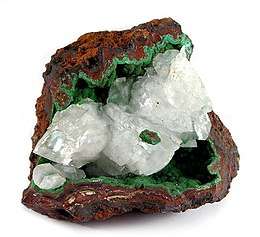 A vug in the limonite matrix is the host for a layer of green botryoids of conichalcite and colorless, translucent rhombs of calcite
A vug in the limonite matrix is the host for a layer of green botryoids of conichalcite and colorless, translucent rhombs of calcite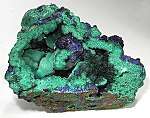 Vug with rosettes of deep blue azurite on a field of malachite
Vug with rosettes of deep blue azurite on a field of malachite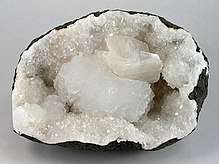 Goosecreekite with heulandite-Ca on quartz
Goosecreekite with heulandite-Ca on quartz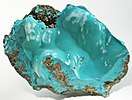 Intergrown botryoids of blue-green rosasite inside the curve of a limonite vug
Intergrown botryoids of blue-green rosasite inside the curve of a limonite vug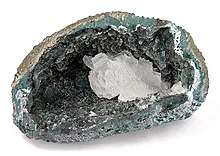 Example of open space in a vug allowing the formation of crystallized minerals
Example of open space in a vug allowing the formation of crystallized minerals Apple green pyromorphite cluster on limonite matrix
Apple green pyromorphite cluster on limonite matrix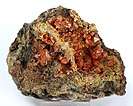 Vug in a limonitic matrix is the host for bi-pyramidal, brownish-red crystals of wulfenite
Vug in a limonitic matrix is the host for bi-pyramidal, brownish-red crystals of wulfenite Crystallized groutite scattered about a hollow vug
Crystallized groutite scattered about a hollow vug In a vug of limonite are intergrown clusters of rhombohedral calcite with inclusions of fibrous aurichalcite
In a vug of limonite are intergrown clusters of rhombohedral calcite with inclusions of fibrous aurichalcite Stellerite, epistilbite, eluorapophyllite in a basaltic vug
Stellerite, epistilbite, eluorapophyllite in a basaltic vug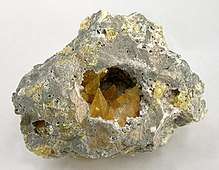 Nestled in its matrix vug are five golden-yellow crystals of sulfur
Nestled in its matrix vug are five golden-yellow crystals of sulfur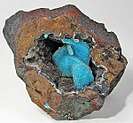 In an open pocket in a matrix of limonite there is a cluster of deep robin's-egg blue chrysocolla with a covering of drusy quartz
In an open pocket in a matrix of limonite there is a cluster of deep robin's-egg blue chrysocolla with a covering of drusy quartz
See also
References
- "Vug – definition of vug". The Free Dictionary. Farlex. Retrieved 2016-04-17.
- Geology Buzz
- The history of Cornwall, civil, military, religious, ... (Page 56), Richard Polwhele - 1816
External links
